Photocatalytic H2 Evolution Using Different Commercial TiO2 Catalysts Deposited with Finely Size-Tailored Au Nanoparticles: Critical Dependence on Au Particle Size
Abstract
:1. Introduction
2. Experimental
2.1. Catalyst Preparation
2.1.1. Photoreduction Procedure
2.1.2. Chemical Reduction Procedure
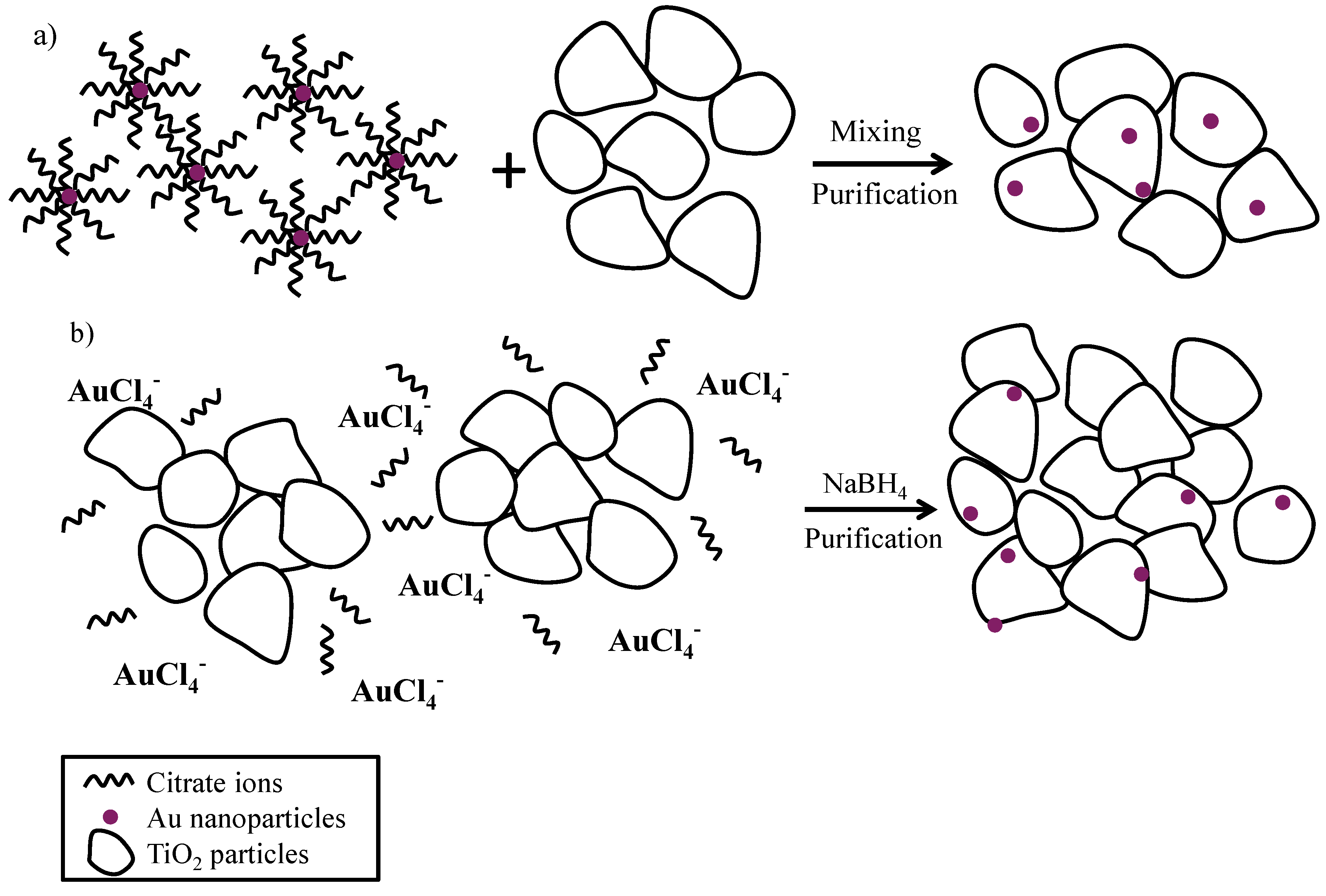
2.2. Characterization of the Catalysts
2.2.1. Spectrophotometry
2.2.2. Transmission Electron Microscopy (TEM)
2.2.3. X-ray Diffraction (XRD)
2.2.4. Energy-Dispersive X-ray Spectroscopy (EDX)
2.2.5. BET Specific Surface Area
2.2.6. X-ray Photoelectron Spectroscopy (XPS)
2.3. H2 Production Measurements
2.4. UV Decomposition of Oxalic Acid
3. Results and Discussion
3.1. Size of Au Nanoparticles
3.1.1. Spectra of Au Solutions
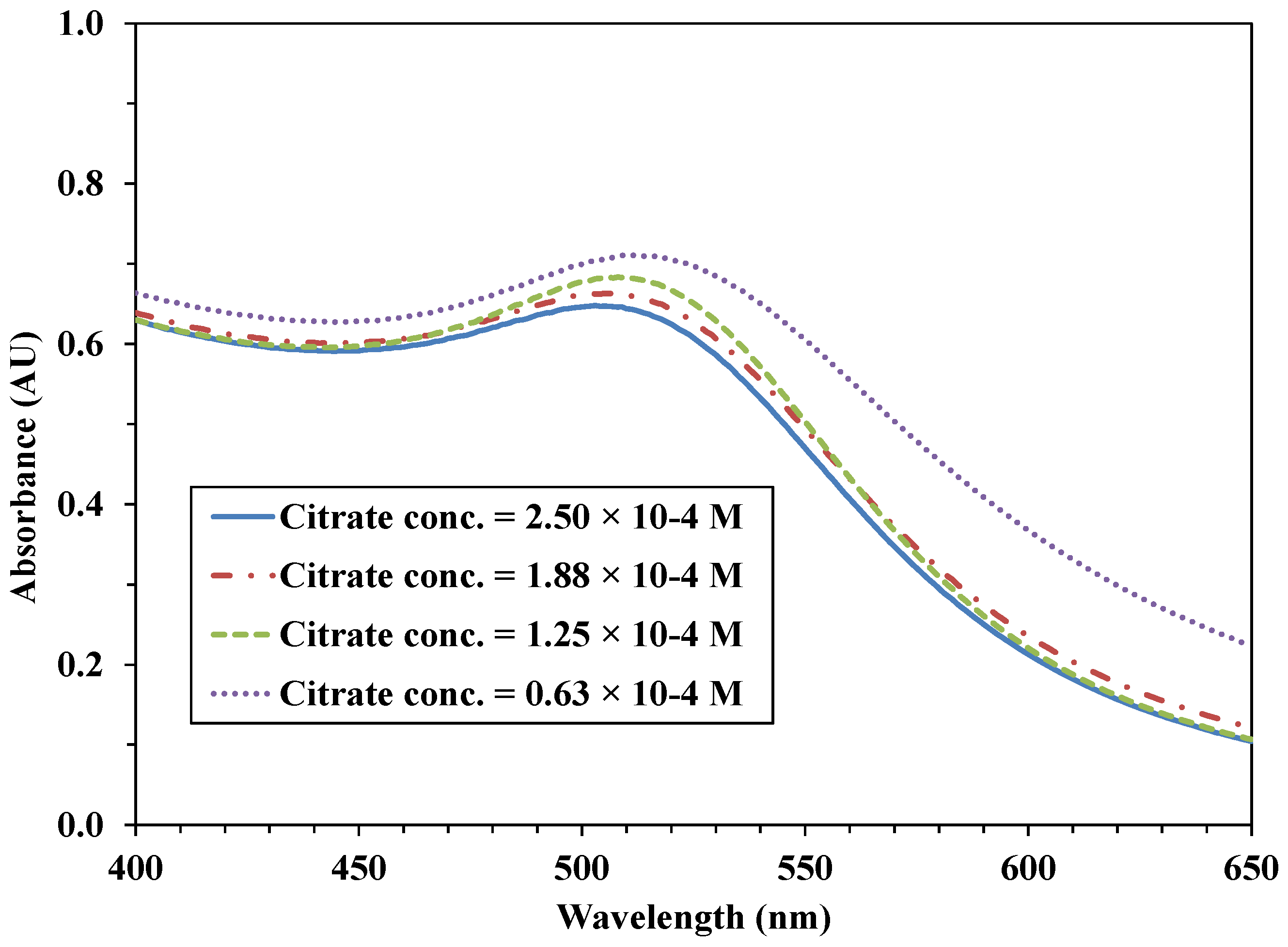
3.1.2. Particle Size of Au on TiO2
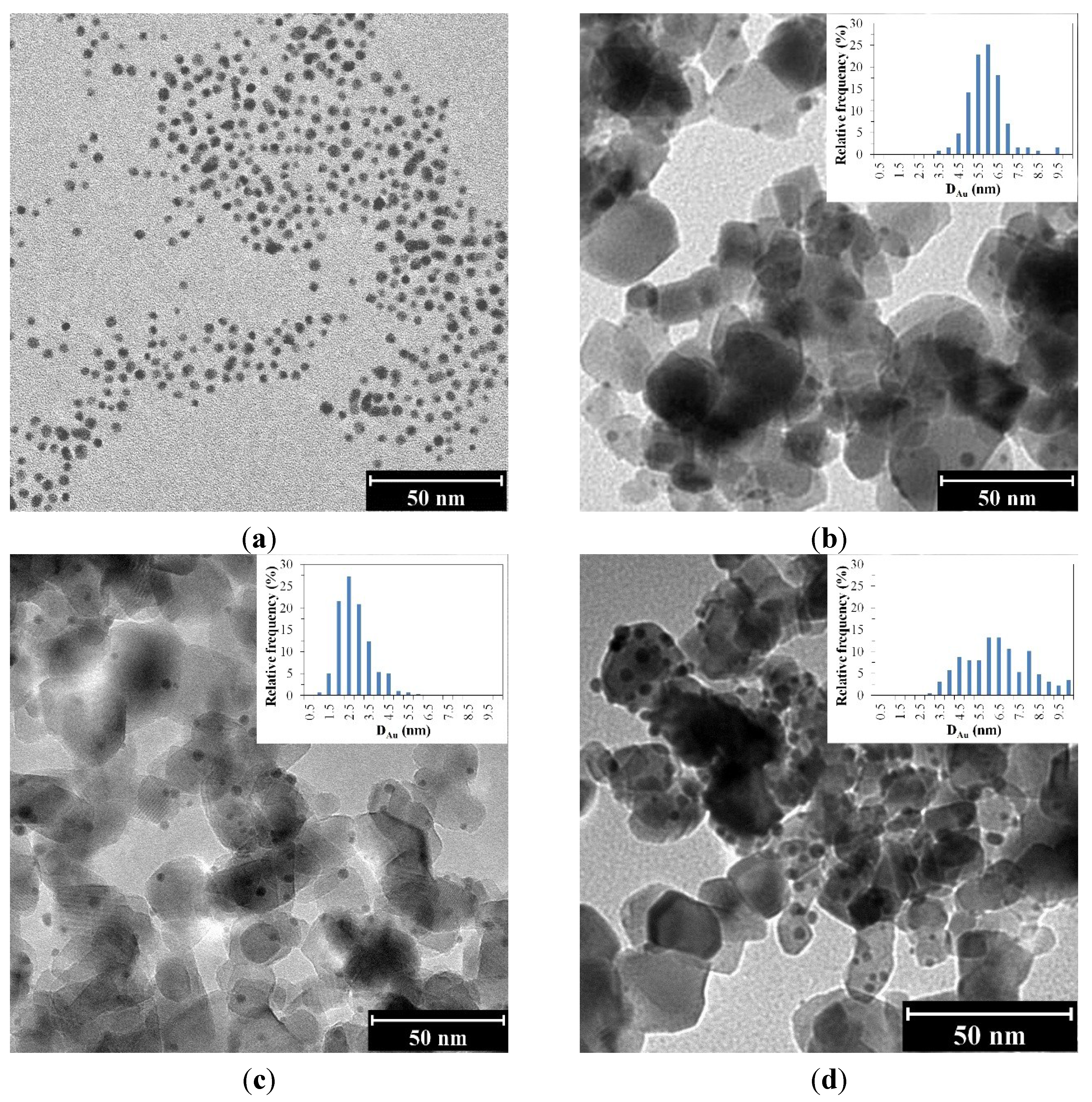
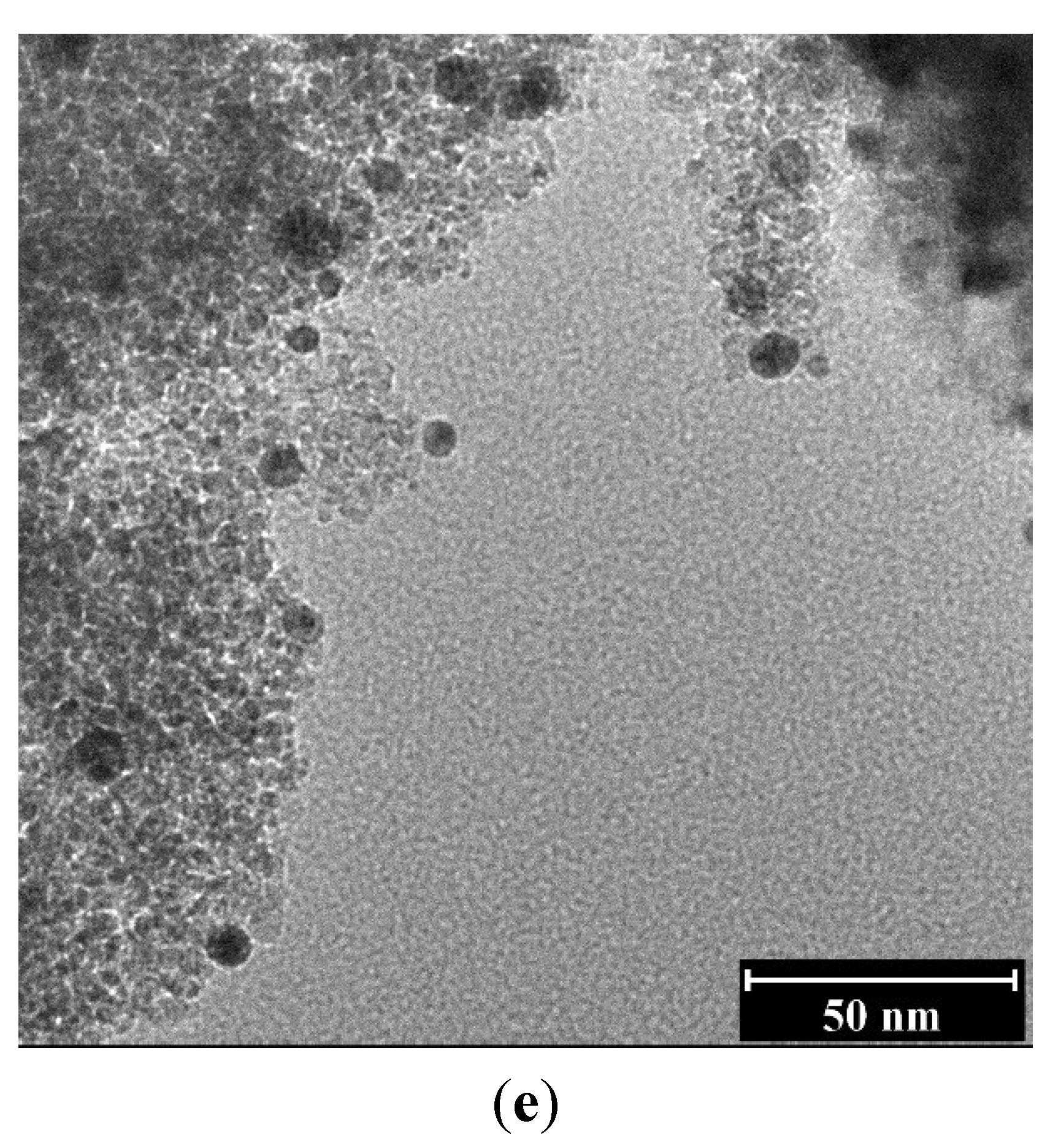
 Au-P25-CRIS,
Au-P25-CRIS,  Au-P25-CRSIM).
Au-P25-CRSIM).
 Au-P25-CRIS,
Au-P25-CRIS,  Au-P25-CRSIM).
Au-P25-CRSIM).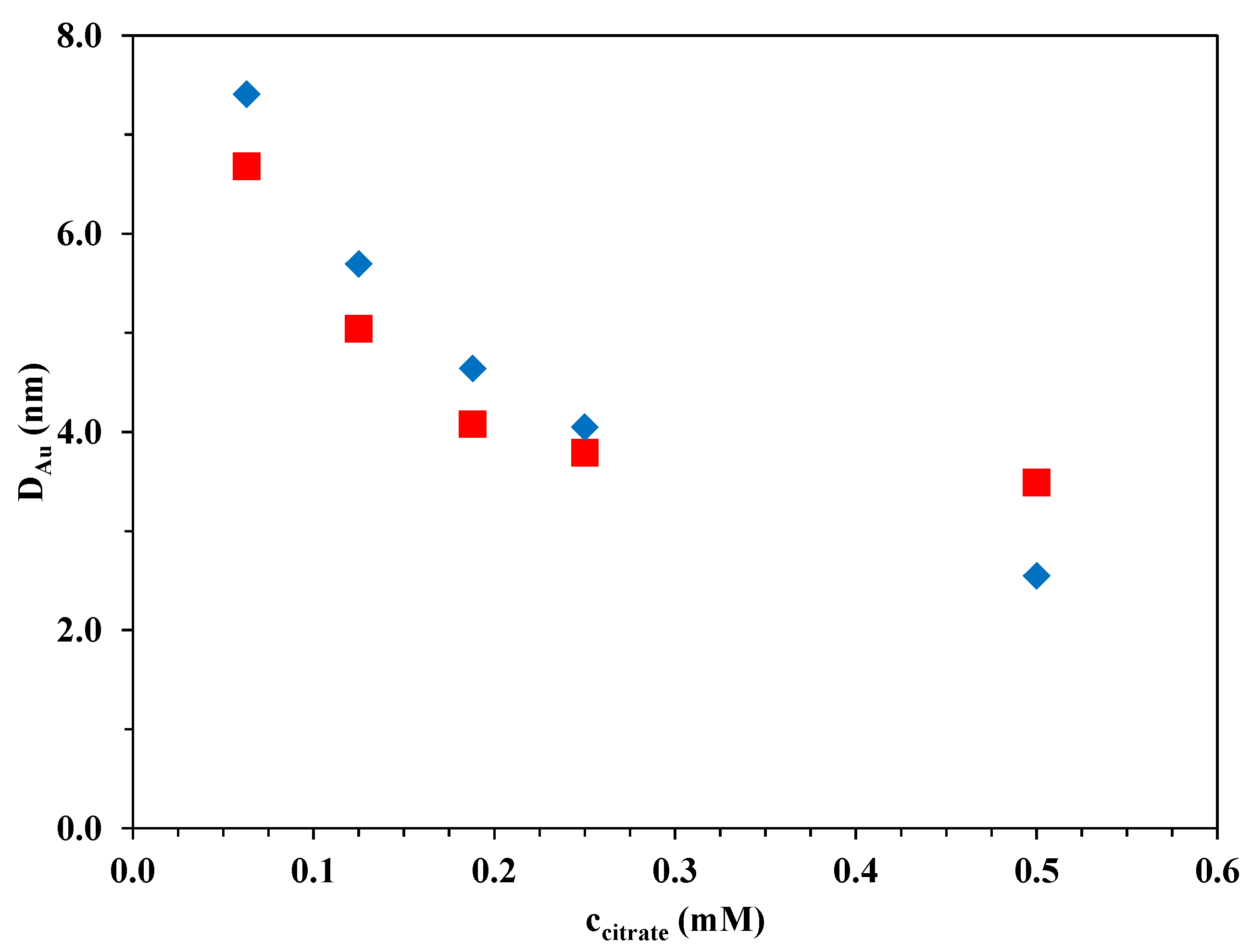
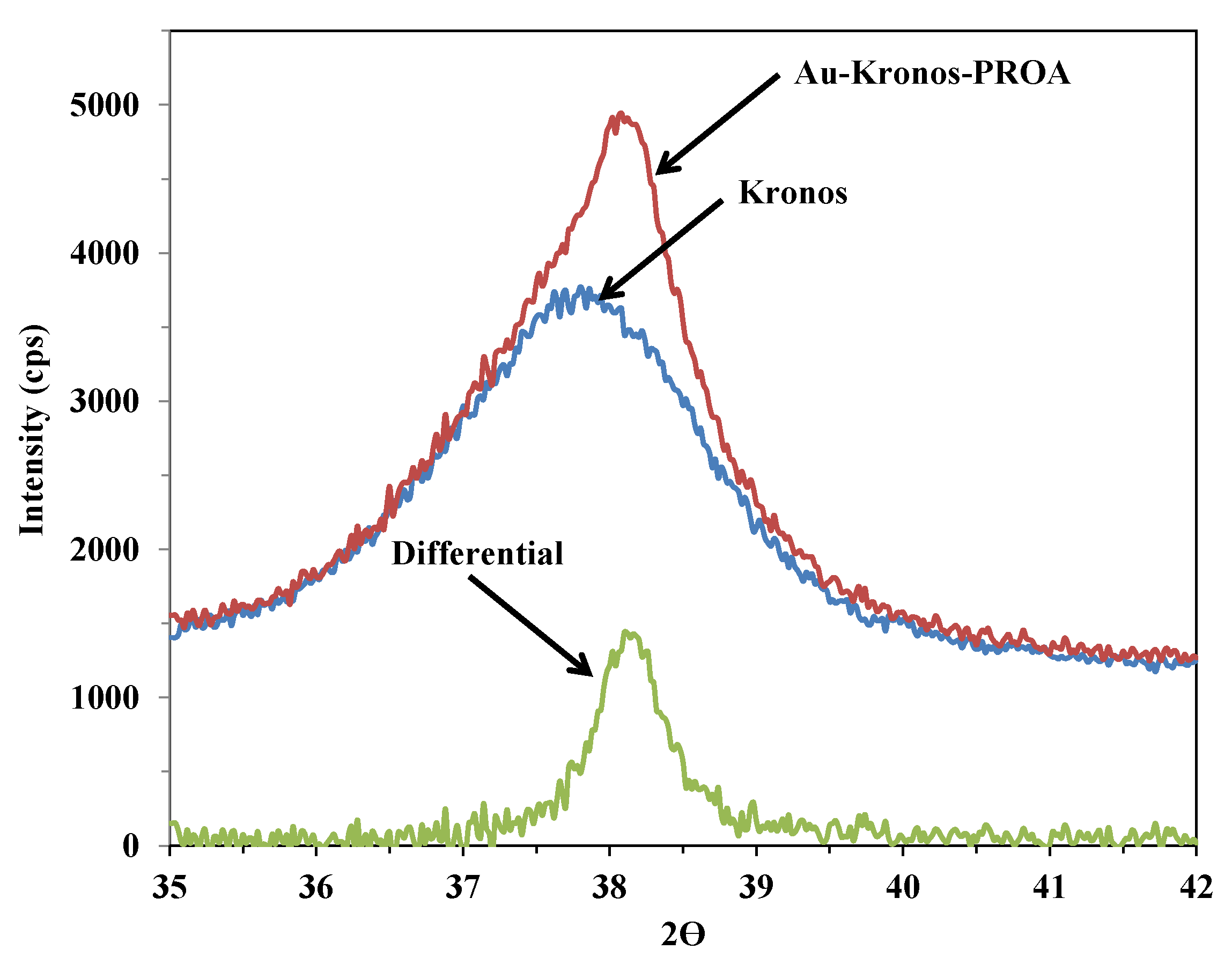
3.1.3. Determination of Au Content with EDX
| Sample | DAu,XRD (nm) | DAu,TEM (nm) | cAu (wt%) |
|---|---|---|---|
| 5.00 × 10−4 M citrate-CRSIM-P25 | – | 3.5 | – |
| 5.00 × 10−4 M citrate-CRIS-P25 | – | 2.6 | – |
| 2.50 × 10−4 M citrate-CRSIM-P25 | – | 3.8 | – |
| 2.50 × 10−4 M citrate-CRIS-P25 | – | 4.0 | – |
| 1.88 × 10−4 M citrate-CRSIM-P25 | – | 4.1 | – |
| 1.88 × 10−4 M citrate-CRIS-P25 | – | 4.6 | – |
| 1.25 × 10−4 M citrate-CRSIM-P25 | – | 5.0 | ~1.07 |
| 1.25 × 10−4 M citrate-CRIS-P25 | – | 5.7 | ~1.15 |
| 0.63 × 10−4 M citrate-CRSIM-P25 | – | 6.7 | – |
| 0.63 × 10−4 M citrate-CRIS-P25 | – | 7.4 | – |
| PRTC-P25 | – | 18.8 | – |
| PROA-P25 | – | 50.0 | ~1.01 |
| 2.50 × 10−4 M citrate-CRSIM-Kronos | 5.9 | – | – |
| 2.50 × 10−4 M citrate-CRIS-Kronos | 9.8 | – | ~0.99 |
| 1.88 × 10−4 M citrate-CRSIM-Kronos | 5.8 | – | ~1.02 |
| 1.88 × 10−4 M citrate-CRIS-Kronos | 6.2 | – | – |
| 1.25 × 10−4 M citrate-CRSIM-Kronos | 7.0 | – | – |
| 1.25 × 10−4 M citrate-CRIS-Kronos | 5.7 | – | – |
| 0.63 × 10−4 M citrate-CRSIM-Kronos | 7.2 | – | – |
| 0.63 × 10−4 M citrate-CRIS-Kronos | 6.4 | – | – |
| PRTC-Kronos | 10.4 | – | – |
| PROA-Kronos | 20.1 | – | ~0.99 |
| DAu (nm) | Au0 4f5/2 (87.82 eV) | Au0 4f7/2 (84.15 eV) |
|---|---|---|
| 7.4 | 45.59% | 54.41% |
| 5.7 | 44.94% | 55.06% |
| 4.0 | 46.12% | 53.88% |
3.2. Photocatalytic Measurements
3.2.1. H2 Evolution from Oxalic Acid Solution
 Au-P25-CRISopt,
Au-P25-CRISopt,  Au-P25-CRSIMopt,
Au-P25-CRSIMopt,  Au-P25-PROA, ● P25;
Au-P25-PROA, ● P25;  Au-Kronos-CRISopt,
Au-Kronos-CRISopt,  Au-Kronos-CRSIMopt,
Au-Kronos-CRSIMopt,  Au-Kronos-PROA, ○ Kronos).
Au-Kronos-PROA, ○ Kronos).
 Au-P25-CRISopt,
Au-P25-CRISopt,  Au-P25-CRSIMopt,
Au-P25-CRSIMopt,  Au-P25-PROA, ● P25;
Au-P25-PROA, ● P25;  Au-Kronos-CRISopt,
Au-Kronos-CRISopt,  Au-Kronos-CRSIMopt,
Au-Kronos-CRSIMopt,  Au-Kronos-PROA, ○ Kronos).
Au-Kronos-PROA, ○ Kronos).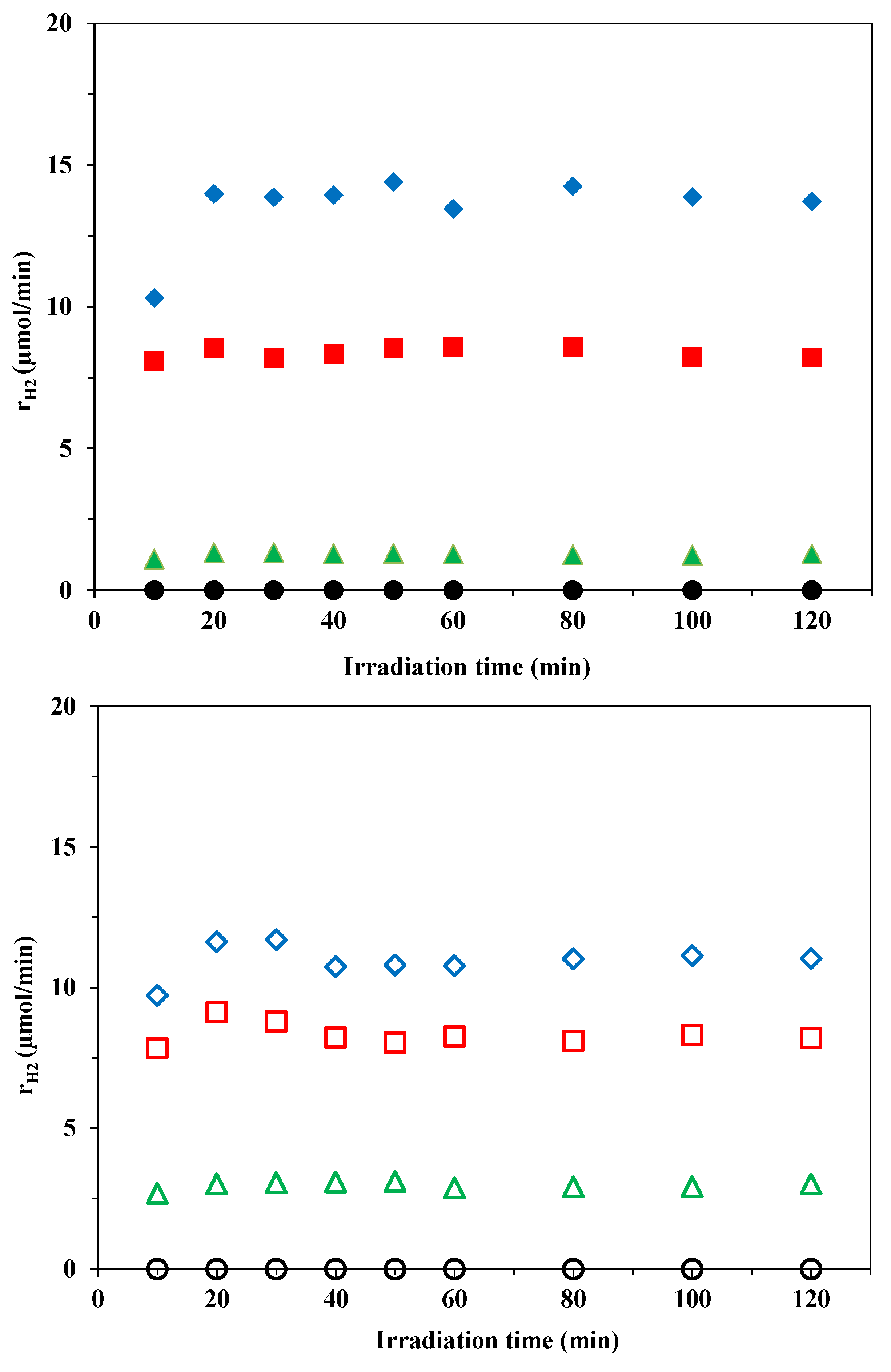
 Au-P25-CRIS,
Au-P25-CRIS,  Au-P25-CRSIM,
Au-P25-CRSIM,  Au-P25-PROA, × Au-P25-PRTC); (b) Kronos Vlp7000 TiO2-based samples (
Au-P25-PROA, × Au-P25-PRTC); (b) Kronos Vlp7000 TiO2-based samples (  Au-Kronos-CRIS,
Au-Kronos-CRIS,  Au-Kronos-CRSIM,
Au-Kronos-CRSIM,  Au-Kronos-PROA, + Au-Kronos-PRTC).
Au-Kronos-PROA, + Au-Kronos-PRTC).
 Au-P25-CRIS,
Au-P25-CRIS,  Au-P25-CRSIM,
Au-P25-CRSIM,  Au-P25-PROA, × Au-P25-PRTC); (b) Kronos Vlp7000 TiO2-based samples (
Au-P25-PROA, × Au-P25-PRTC); (b) Kronos Vlp7000 TiO2-based samples (  Au-Kronos-CRIS,
Au-Kronos-CRIS,  Au-Kronos-CRSIM,
Au-Kronos-CRSIM,  Au-Kronos-PROA, + Au-Kronos-PRTC).
Au-Kronos-PROA, + Au-Kronos-PRTC).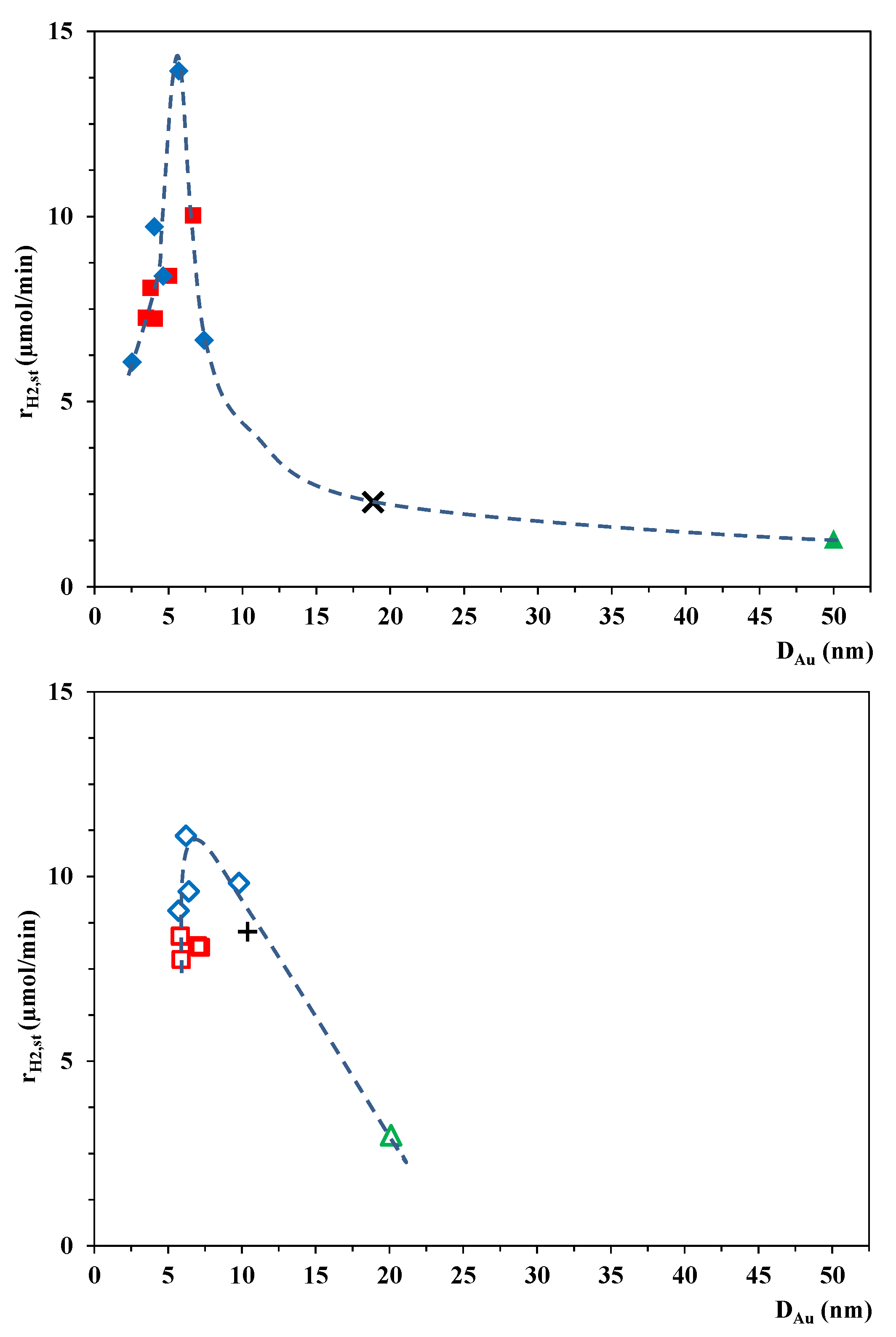
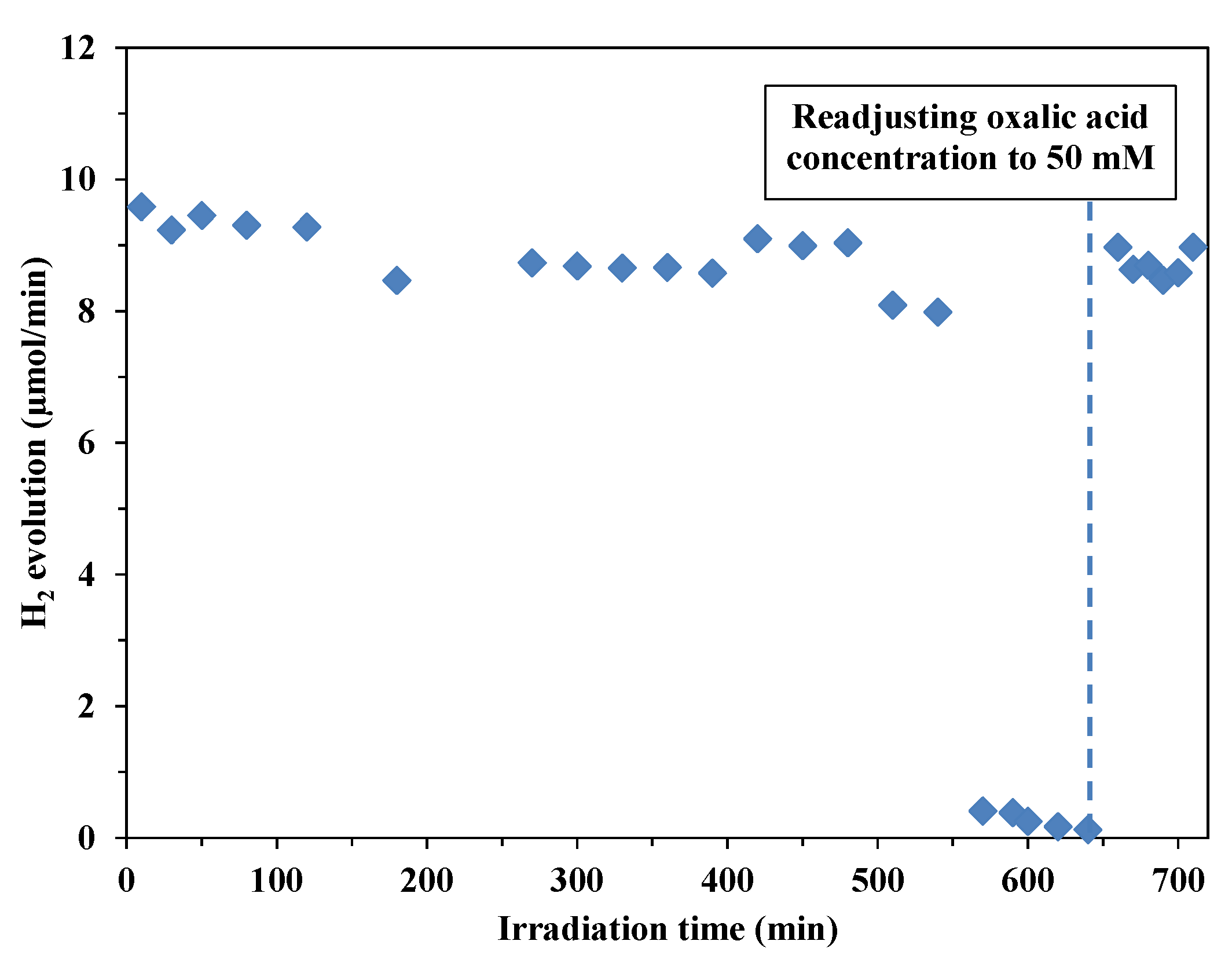
3.2.2. Decomposition of Oxalic Acid under Anaerobic Conditions
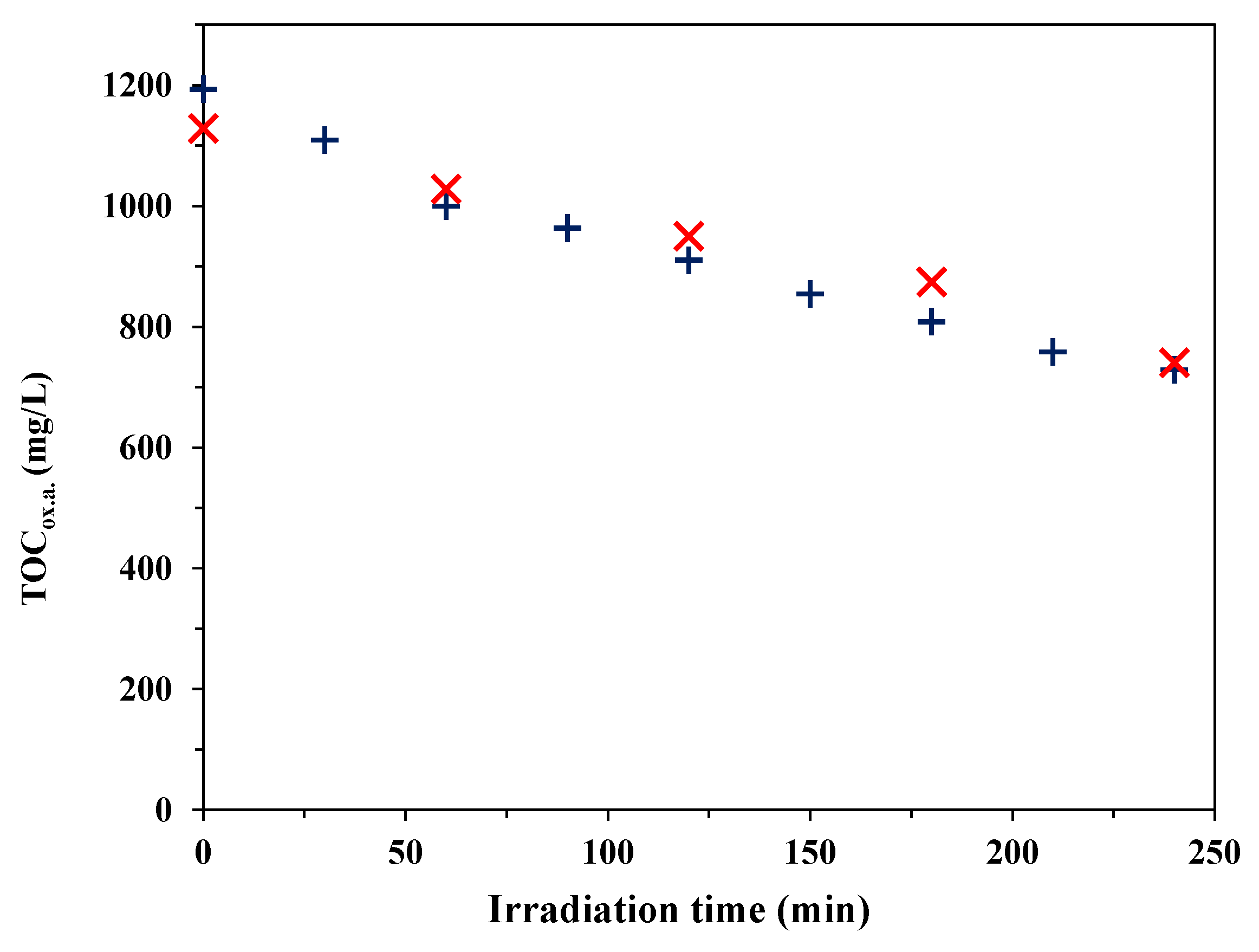
3.2.3. H2 Production from Methanol

3.3. Adsorption of Oxalic Acid on Bare TiO2 Catalysts
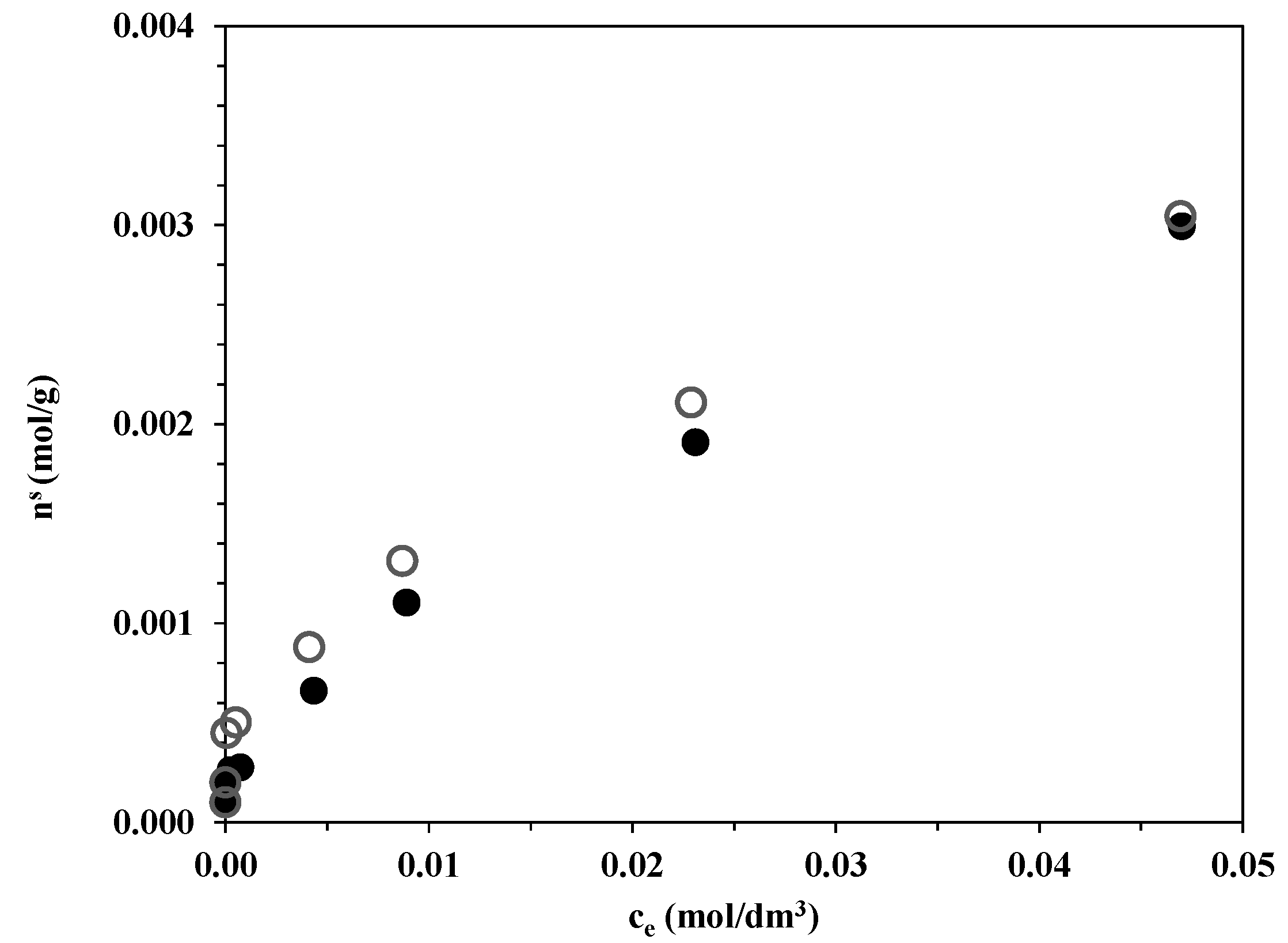
4. Conclusions
Acknowledgments
Author Contributions
Conflicts of Interest
References
- Carp, O.; Huisman, C.L.; Reller, A. Photoinduced reactivity of titanium dioxide. Prog. Solid State Chem. 2004, 32, 33–177. [Google Scholar] [CrossRef]
- Bolton, J.R. Solar photoreduction of hydrogen: A review. Sol. Energy 1996, 57, 37–50. [Google Scholar] [CrossRef]
- Wu, G.; Chen, T.; Su, W.; Zhou, G.; Zong, X.; Lei, Z.; Li, C. H2 production with ultra-low CO selectivity via photocatalytic reforming of methanol on Au/TiO2 catalyst. Int. J. Hydrog. Energy 2008, 33, 1243–1251. [Google Scholar]
- Dawson, A.; Kamat, P.V. Semiconductor-Metal nanocomposites. Photoinduced fusion and photocatalysis of gold-capped TiO2 (TiO2/Gold) nanoparticles. J. Phys. Chem. B 2001, 105, 960–966. [Google Scholar]
- Chiarello, G.L.; Selli, E.; Forni, L. Photocatalytic hydrogen production over flame spray pyrolysis-synthesised TiO2 and Au/TiO2. Appl. Catal. B 2008, 84, 332–339. [Google Scholar] [CrossRef]
- Mizukoshi, Y.; Makise, Y.; Shuto, T.; Hu, J.; Tominaga, A.; Shironita, S.; Tanabe, S. Immobilization of noble metal nanoparticles on the surface of TiO2 by the sonochemical method: Photocatalytic production of hydrogen from an aqueous solution of ethanol. Ultrason. Sonochem. 2007, 14, 387–392. [Google Scholar] [CrossRef] [PubMed]
- Behar, D.; Rabani, J. Kinetics of hydrogen production upon reduction of aqueous TiO2 nanoparticles catalyzed by Pd0, Pt0, or Au0 coatings and an unusual hydrogen abstraction; steady state and pulse radiolysis study. J. Phys. Chem. B 2006, 110, 8750–8755. [Google Scholar] [CrossRef] [PubMed]
- Ikeda, M.; Kusumoto, Y.; Yakushijin, Y.; Somekawa, S.; Ngweniform, P.; Ahmmad, B. Hybridized synergy effect among TiO2, Pt and graphite silica on photocatalytic hydrogen production from water–methanol solution. Catal. Commun. 2007, 8, 1943–1946. [Google Scholar] [CrossRef]
- Dhanalakshmi, K.B.; Latha, S.; Anandan, S.; Maruthamuthu, P. Dye sensitized hydrogen evolution from water. Int. J. Hydrog. Energy 2001, 26, 669–674. [Google Scholar] [CrossRef]
- Yi, H.; Peng, T.; Ke, D.; Ke, D.; Zan, L.; Yan, C. Photocatalytic H2 production from methanol aqueous solution over titania nanoparticles with mesostructures. Int. J. Hydrog. Energy 2008, 33, 672–678. [Google Scholar] [CrossRef]
- Park, J.; Kang, M. Synthesis and characterization of AgxOAgxO, and hydrogen production from methanol photodecomposition over the mixture of AgxOAgxO and TiO2TiO2. Int. J. Hydrog. Energy 2007, 32, 4840–4846. [Google Scholar] [CrossRef]
- Rosseler, O.; Shankar, M.V.; Du, M.K.-L.; Schmidlin, L.; Keller, N.; Keller, V. Solar light photocatalytic hydrogen production from water over Pt and Au/TiO2(anatase/rutile) photocatalysts: Influence of noble metal and porogen promotion. J. Catal. 2010, 269, 179–190. [Google Scholar] [CrossRef]
- Szabó-Bárdos, E.; Czili, H.; Horváth, A. Photocatalytic oxidation of oxalic acid enhanced by silver deposition on a TiO2 surface. J. Photochem. Photobiol. A 2003, 154, 195–201. [Google Scholar] [CrossRef]
- Alonso, F.; Riente, P.; Rodriguezreinoso, F.; Ruizmartinez, J.; Sepulvedaescribano, A.; Yus, M. Platinum nanoparticles supported on titania as an efficient hydrogen-transfer catalyst. J. Catal. 2008, 260, 113–118. [Google Scholar] [CrossRef]
- Chen, T.; Feng, Z.; Wu, G.; Shi, J.; Ma, G.; Ying, P.; Li, C. Mechanistic studies of photocatalytic reaction of methanol for hydrogen production on Pt/TiO2 by in situ fourier transform IR and time-resolved IR spectroscopy. J. Phys. Chem. C 2007, 111, 8005–8014. [Google Scholar] [CrossRef]
- Cui, W.; Feng, L.; Xu, C.; Lü, S.; Qiu, F. Hydrogen production by photocatalytic decomposition of methanol gas on Pt/TiO2 nano-film. Catal. Commun. 2004, 5, 533–536. [Google Scholar] [CrossRef]
- Yang, J.C.; Kim, Y.C.; Shul, Y.G.; Shin, C.H.; Lee, T.K. Characterization of photoreduced Pt/TiO2 and decomposition of dichloroacetic acid over photoreduced Pt/TiO2 catalysts. Appl. Surf. Sci. 1997, 121, 525–529. [Google Scholar] [CrossRef]
- Iliev, V.; Tomova, D.; Todorovska, R.; Oliver, D.; Petrov, L.; Todorovsky, D.; Uzunova-Bujnova, M. Photocatalytic properties of TiO2 modified with gold nanoparticles in the degradation of oxalic acid in aqueous solution. Appl. Catal. A 2006, 313, 115–121. [Google Scholar] [CrossRef]
- Mogyorósi, K.; Kmetykó, Á.; Czirbus, N.; Veréb, G.; Sipos, P.; Dombi, A. Comparison of the substrate dependent performance of Pt-, Au- and Ag-doped TiO2 photocatalysts in H2-production and in decomposition of various organics. React. Kinet. Catal. Lett. 2009, 98, 215–225. [Google Scholar]
- Veres, Á.; Rica, T.; Janovák, L.; Dömök, M.; Buzás, N.; Zöllmer, V.; Seemann, T.; Richardt, A.; Dékány, I. Silver and gold modified plasmonic TiO2 hybrid films for photocatalytic decomposition of ethanol under visible light. Catal. Today 2012, 181, 156–162. [Google Scholar] [CrossRef]
- Zheng, X.-J.; Wei, L.-F.; Zhang, Z.-H.; Jiang, Q.-J.; Wei, Y.-J.; Xie, B.; Wei, M.-B. Research on photocatalytic H2 production from acetic acid solution by Pt/TiO2 nanoparticles under UV irradiation. Int. J. Hydrog. Energy 2009, 34, 9033–9041. [Google Scholar] [CrossRef]
- Sano, T.; Kutsuna, S.; Negishi, N.; Takeuchi, K. Effect of Pd-photodeposition over TiO2 on product selectivity in photocatalytic degradation of vinyl chloride monomer. J. Mol. Catal. A Chem. 2002, 189, 263–270. [Google Scholar] [CrossRef]
- Wojcieszak, R.; Zielinski, M.; Monteverdi, S.; Bettahar, M. Study of nickel nanoparticles supported on activated carbon prepared by aqueous hydrazine reduction. J. Colloid Interface Sci. 2006, 299, 238–248. [Google Scholar] [CrossRef]
- Chen, J.P.; Lim, L.L. Key factors in chemical reduction by hydrazine for recovery of precious metals. Chemosphere 2002, 49, 363–370. [Google Scholar] [CrossRef] [PubMed]
- Naseri, N.; Kim, H.; Choi, W.; Moshfegh, A.Z. Optimal Ag concentration for H2 production via Ag:TiO2 nanocomposite thin film photoanode. Int. J. Hydrog. Energy 2012, 37, 3056–3065. [Google Scholar] [CrossRef]
- Nguyen, D.T.; Kim, D.-J.; So, M.G.; Kim, K.-S. Experimental measurements of gold nanoparticle nucleation and growth by citrate reduction of HAuCl4. Adv. Powder Technol. 2010, 21, 111–118. [Google Scholar] [CrossRef]
- He, P.; Zhu, X. Phospholipid-assisted synthesis of size-controlled gold nanoparticles. Mater. Res. Bull. 2007, 42, 1310–1315. [Google Scholar] [CrossRef]
- Singh, S.K.; Iizuka, Y.; Xu, Q. Nickel-palladium nanoparticle catalyzed hydrogen generation from hydrous hydrazine for chemical hydrogen storage. Int. J. Hydrog. Energy 2011, 36, 11794–11801. [Google Scholar] [CrossRef]
- Liu, X.; Atwater, M.; Wang, J.; Huo, Q. Extinction coefficient of gold nanoparticles with different sizes and different capping ligands. Colloids Surf. B Biointerfaces 2007, 58, 3–7. [Google Scholar] [CrossRef] [PubMed]
- Patsoura, A.; Kondarides, D.I.; Verykios, X.E. Enhancement of photoinduced hydrogen production from irradiated Pt/TiO2 suspensions with simultaneous degradation of azo-dyes. Appl. Catal. B 2006, 64, 171–179. [Google Scholar] [CrossRef]
- Yin, S.; Sato, T. Photocatalytic activity of platinum loaded fibrous titania prepared by solvothermal process. J. Photochem. Photobiol. A 2005, 169, 89–94. [Google Scholar] [CrossRef]
- Chiarello, G.L.; Aguirre, M.H.; Selli, E. Hydrogen production by photocatalytic steam reforming of methanol on noble metal-modified TiO2. J. Catal. 2010, 273, 182–190. [Google Scholar] [CrossRef]
- Sreethawong, T.; Suzuki, Y.; Yoshikawa, S. Platinum-loaded mesoporous titania by single-step sol-gel process with surfactant template: Photocatalytic activity for hydrogen evolution. C. R. Chim. 2006, 9, 307–314. [Google Scholar] [CrossRef]
- Dubey, N.; Rayalu, S.; Labhsetwar, N.; Devotta, S. Visible light active zeolite-based photocatalysts for hydrogen evolution from water. Int. J. Hydrog. Energy 2008, 33, 5958–5966. [Google Scholar] [CrossRef]
- Bamwenda, G.R.; Tsubota, S.; Nakamura, T.; Haruta, M. Photoassisted hydrogen production from a water-ethanol solution: A comparison of activities of Au-TiO2 and Pt-TiO2. J. Photochem. Photobiol. A 1995, 89, 177–189. [Google Scholar] [CrossRef]
- Yang, Y.; Chang, C.; Idriss, H. Photo-catalytic production of hydrogen form ethanol over M/TiO2 catalysts (M=Pd, Pt or Rh). Appl. Catal. B 2006, 67, 217–222. [Google Scholar] [CrossRef]
- Li, Y.; Xie, Y.; Peng, S.; Lu, G.; Li, S. Photocatalytic hydrogen generation in the presence of chloroacetic acids over Pt/TiO2. Chemosphere 2006, 63, 1312–1318. [Google Scholar] [CrossRef] [PubMed]
- Chen, T.; Wu, G.; Feng, Z.; Hu, G.; Su, W.; Ying, P.; Li, C. In situ FT-IR study of photocatalytic decomposition of formic acid to hydrogen on Pt/TiO2 catalyst. Chin. J. Catal. 2008, 29, 105–107. [Google Scholar] [CrossRef]
- Fu, X.; Long, J.; Wang, X.; Leung, D.; Ding, Z.; Wu, L.; Zhang, Z.; Li, Z. Photocatalytic reforming of biomass: A systematic study of hydrogen evolution from glucose solution. Int. J. Hydrog. Energy 2008, 33, 6484–6491. [Google Scholar] [CrossRef]
- Daskalaki, V.M.; Kondarides, D.I. Efficient production of hydrogen by photo-induced reforming of glycerol at ambient conditions. Catal. Today 2009, 144, 75–80. [Google Scholar] [CrossRef]
- Veisz, B.; Király, Z. Size-Selective synthesis of cubooctahedral palladium particles mediated by metallomicelles. Langmuir 2003, 19, 4817–4824. [Google Scholar] [CrossRef]
- Murdoch, M.; Waterhouse, G.I.N.; Nadeem, M.A.; Metson, J.B.; Keane, M.A.; Howe, R.F.; Llorca, J.; Idriss, H. The effect of gold loading and particle size on photocatalytic hydrogen production from ethanol over Au/TiO2 nanoparticles. Nat. Chem. 2011, 3, 489–492. [Google Scholar] [PubMed]
- Wu, Z.; Liang, J.; Ji, X.; Yang, W. Preparation of uniform Au@SiO2 particles by direct silica coating on citrate-capped Au nanoparticles. Colloids Surf. A 2011, 392, 220–224. [Google Scholar] [CrossRef]
- Tanaka, A.; Sakaguchi, S.; Hashimoto, K.; Kominami, H. Preparation of Au/TiO2 with metal cocatalysts exhibiting strong surface plasmon resonance effective for photoinduced hydrogen formation under irradiation of visible light. ACS Catal. 2013, 3, 79–85. [Google Scholar] [CrossRef]
- Chang, F.-W.; Yu, H.-Y.; Selva Roselin, L.; Yang, H.-C. Production of hydrogen via partial oxidation of methanol over Au/TiO2 catalysts. Appl. Catal. A 2005, 290, 138–147. [Google Scholar] [CrossRef]
- Fan, L.; Ichikuni, N.; Shimazu, S.; Uematsu, T. Preparation of Au/TiO2 catalysts by suspension spray reaction method and their catalytic property for CO oxidation. Appl. Catal. A 2003, 246, 87–95. [Google Scholar] [CrossRef]
- Subramanian, V.; Wolf, E.E.; Kamat, P.V. Influence of metal/metal ion concentration on the photocatalytic activity of TiO2-Au composite nanoparticles. Langmuir 2003, 19, 469–474. [Google Scholar] [CrossRef]
- Ismail, A.A.; Al-Sayari, S.A.; Bahnemann, D.W. Photodeposition of precious metals onto mesoporous TiO2 nanocrystals with enhanced their photocatalytic activity for methanol oxidation. Catal. Today 2013, 209, 2–7. [Google Scholar] [CrossRef]
© 2014 by the authors; licensee MDPI, Basel, Switzerland. This article is an open access article distributed under the terms and conditions of the Creative Commons Attribution license (http://creativecommons.org/licenses/by/4.0/).
Share and Cite
Kmetykó, Á.; Mogyorósi, K.; Pusztai, P.; Radu, T.; Kónya, Z.; Dombi, A.; Hernádi, K. Photocatalytic H2 Evolution Using Different Commercial TiO2 Catalysts Deposited with Finely Size-Tailored Au Nanoparticles: Critical Dependence on Au Particle Size. Materials 2014, 7, 7615-7633. https://doi.org/10.3390/ma7127615
Kmetykó Á, Mogyorósi K, Pusztai P, Radu T, Kónya Z, Dombi A, Hernádi K. Photocatalytic H2 Evolution Using Different Commercial TiO2 Catalysts Deposited with Finely Size-Tailored Au Nanoparticles: Critical Dependence on Au Particle Size. Materials. 2014; 7(12):7615-7633. https://doi.org/10.3390/ma7127615
Chicago/Turabian StyleKmetykó, Ákos, Károly Mogyorósi, Péter Pusztai, Teodora Radu, Zoltán Kónya, András Dombi, and Klára Hernádi. 2014. "Photocatalytic H2 Evolution Using Different Commercial TiO2 Catalysts Deposited with Finely Size-Tailored Au Nanoparticles: Critical Dependence on Au Particle Size" Materials 7, no. 12: 7615-7633. https://doi.org/10.3390/ma7127615






